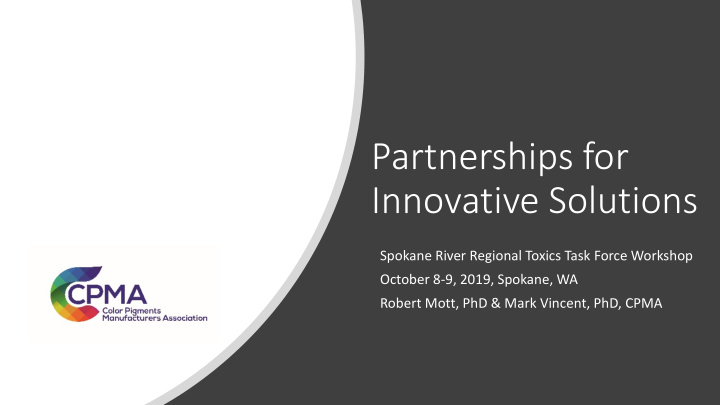



Partnerships for Innovative Solutions Spokane River Regional Toxics Task Force Workshop October 8-9, 2019, Spokane, WA Robert Mott, PhD & Mark Vincent, PhD, CPMA
About CPMA • Formed in 1925, the Color Pigments Manufacturers Association is the recognized industry voice for manufacturers, importers , suppliers and distributors in North America. • Promotes compliance with safety, health and environmental laws and regulations in North America. • Engages with policy makers, regulators, customer trade associations and value chain stakeholders to address and communicate issues impacting the color pigments industry. • Provides membership forums for sharing industry best practices to assist members in better serving their shareholders, customers, employees and society.
Pigments are colored, black, white or fluorescent particulate organic or inorganic solids which usually are insoluble in, and essentially physically and chemically unaffected by, the vehicle or substrate in which they are incorporated Pigments alter appearance by selective absorption and/or by scattering of light What are color Pigments are usually dispersed in vehicles or substrates for application, as for instance in the pigments? manufacture or inks, paints, plastics or other polymeric materials Pigments retain a crystal or particulate structure throughout the coloration process (Safe Handling of Color Pigments, Color Pigments Manufacturers Association Inc., First Edition, 1993)
Dye (soluble) vs Pigment (insoluble)
Diazo Coupling Packing of Tank Component Grinder Pigment powder Tank Acid Manufacturing Alkali Drier Process Steam Ice Granulator Strike Tank Filter Press with agitation
Digital Printing Offset Printing C.I. Pigment Blue 15:x C.I. Pigment Blue 15:x C.I. Pigment Red 57:1 C.I. Pigment Red 57:1 Color C.I. Pigment Yellow 13 C.I. Pigment Red 122 Pigments Used C.I. Pigment Black 7 C.I. Pigment Violet 19 in Printing Ink C.I. Pigment Red 52:1 (primarily C.I. Pigment Yellow 150 in the US) Applications C.I. Pigment Yellow 74 C.I. Pigment Yellow 14 (primarily C.I. Pigment Black 7 in the US) C.I. Pigment Yellow 12 (low cost and lightfastness)
Lithographic Flexographic C.I. Pigment Blue 15:x C.I. Pigment Blue 15:x Color C.I. Pigment Red 57:1 C.I. Pigment Red 57:1 Pigments Used C.I. Pigment Yellow 13 C.I. Pigment Yellow 13 C.I. Pigment Black 7 C.I. Pigment Black 7 in Printing Ink C.I. Pigment Red 52:1 C.I. Pigment Red 52:1 Applications (primarily in the US) (primarily in the US) C.I. Pigment Yellow 14 C.I. Pigment Yellow 14 (primarily in the US) (primarily in the US) C.I. Pigment Yellow 12 (low C.I. Pigment Yellow 12 (low cost and lightfastness) cost and lightfastness)
Color Pigments Characteristics & Customer Requirements Chroma Fitness for purpose (performance level) Broad shade functionality Regulatory status Durability/lightfastness Cost Opacity/transparency Availability Low metamerism Dispersibilty Heat stability Solvent resistance Transparent Opaque Gloss retention Color strength Good Bad Good Poor Dispersibility Dispersibility Durability Durability
Commercial Applications Value Chain Integration Printing Ink Technical Specifications Industry Customer Manufacturing Cost Requirements Supply Chain Delivery Customer Preferences (Global)
Color Pigments Regulatory Compliance • Manufacturing Regulations (EPA, OSHA, ECCC, HC) • Product Applications (EPA, FDA, CPSC, FIFRA, HC) • Chemicals Registrations (EPA, ECCC, ECHA, REACH) • Chemicals Labeling (GHS, Proposition 65, REACH) • Batch Chemical Processing (CAA, CWA, EPCRA, RCRA, CEPA)
2016 Canada Assessment of Monoazo Pigments (No risk to human health or the environment) 2014 Canada Assessment of Diarylide Pigments (No risk to human health or the environment) 2010 USEPA Benzidine Dyes Action Plan (No Exposure concern for pigments in printing inks) 2010 REACH Dossiers for Diarylide Pigments (Safe for Color Pigments intended use) Regulatory 2010 REACH Dossiers for Phthalocyanine Pigments (Safe for intended use) Assessment 2005 OECD SIDS Dossiers for Phthalocyanine Pigments (Low hazard) 2003 OECD SIDS Dossiers for Diarylide Pigments (Low hazard) 1995 TRI Delisting for Phthalocyanine Pigments (Low hazard) 1994 OECD SIDS Dossier for Monoazo Pigments (Safe for intended use)
PCBs & Color Pigments Perspectives: Actuality: Industry has modified manufacturing processes and product formulations since 1990’s to minimize Industry has not done anything to address inadvertent PCBs and ensure compliance with inadvertent PCBs global regulations It is easy to substitute color pigments in printing ink Each pigment is unique to meet specific technical formulations and application requirements Pigments and dyes PCB-11 impact at 0.02-31 kg for Incorrect calculations and conclusions cited in PCBs Washington State related studies 250mm tons (500 billion pounds) or organic Global color pigments production information pigments produced annually, of which 25% are greatly exaggerated and not substantiated by Diarylides government trade data Color pigments from printing inks are the primary Comprehensive studies haven’t been conducted to source of PCB-11 in Spokane River identify all potential sources of PCB-11 Product tests identify inadvertent PCBs in packaging Product tests reveal inadvertent PCBs levels are and products significantly below federal regulatory limits PPQ WA water discharge permit requirements will PPQ is comparable to background levels in nature, greatly improve water quality a non-detect level; technology doesn’t exist to achieve PPQ
Contact: Thank you! David Wawer CPMA Executive Director davidwawer@cpma.com
Recommend
More recommend